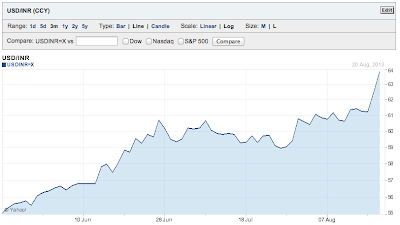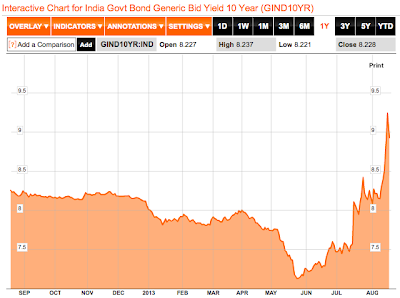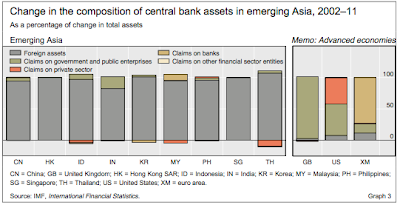One set of issues facing the world's economy that is getting cursory coverage on the west side of the Atlantic Ocean are the recent problems in India. India's currency, bonds and stock market are all getting hammered and not in the "fun way".
Here is a look at what has happened to India's rupee against the United States dollar over the past five years:
Here's what has happened to the rupee since the beginning of June 2013:
One year ago, the conversion from rupees to dollars hit a low of 51.38. Today, it is at 64.04 rupees to the dollar, a new record low. That's a depreciation rate of 24.6 percent on a year-over-year basis.
This is what has happened to the yield on India's 10 year bonds over the past year:
That chart is reminiscent of bond yields in Europe during the depths of Europe's crisis, isn't it? On August 16th, yields spiked to a high of 8.898 percent and thanks to intervention by India's central bank who bought $1.2 billion (Rs 8,000 crore – one crore is 10,000,000) worth of their own long dated bonds on August 23, 2013 to stem the flood of investors out of the rupee, yields dropped slightly to their current rate of just over 8.2 percent.
India is considered by many economists as one of the world's key economies, earning the nation a place in the BRIC nations. It is growth in these economies that has kept the world's economic engine firing on at least some of its cylinders. As background information, in 2012, India's GDP (purchasing power parity) reached $4.761 trillion, putting it in fourth place in the world. It's real GDP growth rate in 2012 was estimated at 6.5 percent, down from 7.7 percent in 2011 and 11.2 percent in 2010. This real growth rate puts India's economy at 34th place overall. India has the world's second largest labor force of 486.6 million people and had an estimated unemployment rate in 2012 of 8.5 percent. As you can see, India is very important to the world's economy, particularly because it has a burgeoning middle class that loves to consume.
What caused India's problem? India need look no further than the esteemed Mr. Bernanke of the Federal Reserve. His long-term experiment with bond-buying and low interest rates has flooded the world's currency markets with cheap money that found a new home in the world's emerging markets in a search for a reasonable yield. As I posted here over a year ago, central banks in Asia have intervened heavily in foreign exchange markets to keep the value of their currencies from rising too quickly which would affect their ability to export cheap goods. As such, Asia's central banks, including that of India, have seen their balance sheets balloon with foreign reserve assets as shown on this bar graph:
As the Fed begins to taper its purchases of securities, this cheap money will be withdrawn from the system, adding further misery to India, putting additional downward pressure on its currency and upward pressure on its interest rates as the Fed allows interest rates to rise once again. This will push up the yields on Treasuries which are generally viewed as a more secure investment than India's bonds. As the demand for India's bonds drops, the price will rise and since bond prices act inversely to yields, the yield on India's bonds could well continue to be under upward pressure as they are now.
Unfortunately, India is not the only developing nation with a problem related to the Fed's withdrawal of its special brand of stimulus. Indonesia's currency, the rupiah, has fallen to a four year low against the U.S. dollar and its stock market is also undergoing a significant correction.
If the rupee stays at its current low value, India's economy is likely to experience an increased level of inflation as the price of imports rises. As the world found out in 1997 during the Asian crisis, when Asia catches the "fiscal flu", the entire world feels its effects. In 1997, the crisis cascaded through Asia and ended up affecting most of the major and minor economies in the area. At this point in time, India, in particular, is already "sneezing" and the supposed cause of its ills are related to the conjecture that the end of easing is set for some point in the future. How bad will it be when the Fed really does taper?
I've long termed the implementation of quantitative easing by the world's key central bankers as an "experiment". This "experiment", previously untested on such a massive scale, is about to reveal the true nature of its efficacy on the world's economy. Unfortunately, the end result could well be very, very ugly. We may find that India is just the tip of the iceberg.
Click HERE to read more of Glen Asher's columns
You can publish this article on your website as long as you provide a link back to this page.





Be the first to comment